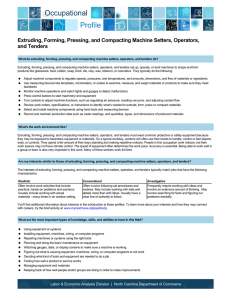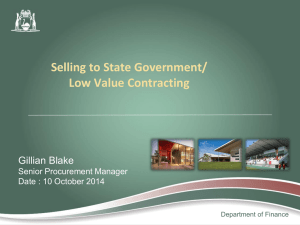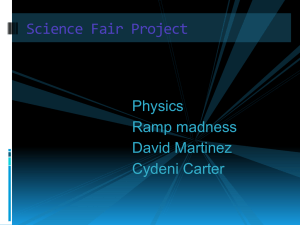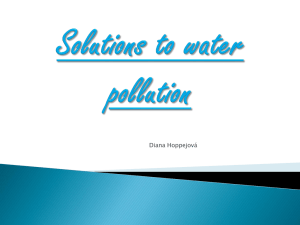How can Human Resources affect Corporate Site Selection
advertisement
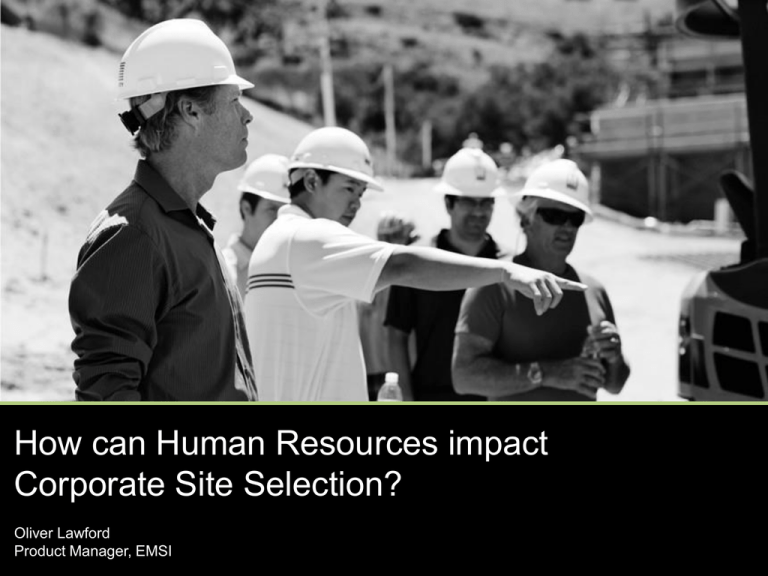
How can Human Resources impact Corporate Site Selection? Oliver Lawford Product Manager, EMSI Goals 1. Give you a framework to understand human capital issues within site selection process 2. Begin to show you how to apply strategic human capital data to influence site selections decisions. 2 Why is this important? Reason One New site selection or relocation are vital to business strategy. -Technological Advances -Human Capital Requirements -New Products or Services -New Markets -New Distribution channels or suppliers 3 Why is this important? Reason Two Site Selection decisions are expensive, complicated, time consuming and hard to correct. 4 Why is this important? Reason Three In general, the most important site selection criteria are human capital issues. Availability of skilled labor (1st) Cost of labor (3rd) 5 "With organizations now focused on...entering new geographic markets, human resources must arm its business leadership with the labor market essentials. The right information can position a company in geographic locations where they can improve their odds of success." 6 How does this affect HR? This is a perfect opportunity for HR and Talent Acquisition to have a significant impact on business outcomes. Not just focused on operation efficiency. 7 Site Selection Process 8 Process Phase Zero Be aware of the overarching business strategy over the next five years. 9 Process Phase One Determine which criteria your business cares about and how much. These might include: ─ ─ ─ ─ ─ ─ Workforce Requirements Land Requirements Customer Proximity Utility Costs Cost of Living Communications and Infrastructure 10 Process Phase Two Choose a particular location that best meets business needs. Keep 1-2 backup locations available. Consult real estate advisory services, or real estate databases Solicit information from communities regarding incentives (type, value and duration) 11 Process Phase Three Negotiation and final selection. Brinksmanship! 12 Business Criteria 13 14 Business Criteria What does a company like Tesla care about when building a Gigafactory? 1. 2. 3. 4. 5. Transport Services Finance Workforce Other 15 Transport Environment Proximity to road and rail is a high priority in order to transport batteries back to California for final assembly Proximity to water (medium) Commute times (medium) Proximity to major airport (low) 16 Services Environment Utility requirements are a high priority considering the size of the factory (5-10 million square feet; largest battery factory in the world) Land requirements (medium high) Telecommunications (medium) 17 Financial Environment Incentives Taxes Cost of living Construction costs The importance of incentives are often hard to quantify before a decision is made. Some companies are clear as to there importance, like Tesla. 18 Other Quality of living (medium high) Proximity to training/schools (medium) Competitor proximity (low) Customer proximity (low) 19 Workforce Availability and cost of labor (high) Workforce Demographics (diversity) Labor Unionization (cost issue) 20 So where did Tesla go? 21 22 Motivating factors $1.25 billion incentive package with the state of Nevada (10th biggest in US history) Quality of living (proximity to Lake Tahoe, mountains etc.) Growing technology presence (Microsoft, Apple, Intuit, Ashima) Zero Corporate Income Tax 23 24 Let’s apply some data 25 Simple Process Industries Staffing Patterns Individual Occupations 26 Industries By focusing on your industry (or closely aligned industries) you are able to identify the existing workforce with closely matched skills and experience. What is Tesla’s industry? 27 28 Tesla’s Industry If Tesla moved to recruit existing workers in their industry they should have moved to somewhere like… Missouri (7.81) or Kansas (7.77) or Kentucky (3.94) 29 Other Industries Other closely aligned industries present compatible talent pools. Tesla could recruit from industries like Motor Vehicle Electrical and Electronic Equipment Manufacturers. Those jobs are predominantly in the Midwest or Southeast. 30 Simple Framework Industries Staffing Patterns Individual Occupations 31 Staffing Patterns Using Staffing patterns we can identify the jobs which drive a particular industry. Then we can identify whether they exist in other industries. 32 Staffing Patterns Machine Setters, Material Movers, Team Assemblers, Maintenance Workers, General Managers, Electrical Equipment Assemblers, Inspectors, Machinists, Electrical Engineers, Customer Service Representatives, Industrial Engineers, Cutting/Punching Machine Setters, Shipping Clerks 33 Top 10 Jobs (CA) 2014 Jobs 2014 - 2019 % Change 2014 - 2019 Change Maintenance and Repair Workers, General 123,527 6% 7,709 First-Line Supervisors of Production and Operating Workers 53,581 (2%) (809) Electrical and Electronic Equipment Assemblers 30,022 (2%) (554) Team Assemblers 88,116 (1%) (1,054) 4,977 (9%) (439) 10,155 (11%) (1,119) 5,567 (7%) (365) Inspectors, Testers, Sorters, Samplers, and Weighers 51,021 3% 1,508 Production Workers, All Other 20,569 4% 917 Laborers and Freight, Stock, and Material Movers, Hand 294,479 6% 18,722 682,014 4% 24,516 Description Extruding and Drawing Machine Setters, Operators, and Tenders, Metal and Plastic Molding, Coremaking, and Casting Machine Setters, Operators, and Tenders, Metal and Plastic Multiple Machine Tool Setters, Operators, and Tenders, Metal and Plastic 34 Top 10 Jobs (TX) 2014 Jobs 2014 - 2019 % Change 2014 - 2019 Change Maintenance and Repair Workers, General 112,020 9% 9,838 First-Line Supervisors of Production and Operating Workers 47,914 4% 2,151 Electrical and Electronic Equipment Assemblers 17,756 2% 312 Team Assemblers 65,098 8% 5,074 Extruding and Drawing Machine Setters, Operators, and Tenders, Metal and Plastic 5,330 (4%) (188) Molding, Coremaking, and Casting Machine Setters, Operators, and Tenders, Metal and Plastic 6,880 (6%) (401) Multiple Machine Tool Setters, Operators, and Tenders, Metal and Plastic 5,886 3% 178 45,254 7% 3,174 9,662 11% 1,104 203,921 8% 16,692 519,721 7% 37,935 Description Inspectors, Testers, Sorters, Samplers, and Weighers Production Workers, All Other Laborers and Freight, Stock, and Material Movers, Hand 35 Top 10 Jobs (AZ) 2014 Jobs 2014 - 2019 % Change 2014 - 2019 Change 23,913 1,553 6% First-Line Supervisors of Production and Operating Workers 8,258 240 3% Electrical and Electronic Equipment Assemblers 4,486 (113) (3%) 12,476 (475) (4%) 559 (23) (4%) 1,507 (148) (10%) 335 23 7% Inspectors, Testers, Sorters, Samplers, and Weighers 7,775 418 5% Production Workers, All Other 3,179 (184) (6%) 37,900 613 2% 100,389 1,904 2% Description Maintenance and Repair Workers, General Team Assemblers Extruding and Drawing Machine Setters, Operators, and Tenders, Metal and Plastic Molding, Coremaking, and Casting Machine Setters, Operators, and Tenders, Metal and Plastic Multiple Machine Tool Setters, Operators, and Tenders, Metal and Plastic Laborers and Freight, Stock, and Material Movers, Hand 36 Top 10 Jobs (NM) 2014 Jobs 2014 - 2019 % Change 2014 - 2019 Change Maintenance and Repair Workers, General 7,772 6% 489 First-Line Supervisors of Production and Operating Workers 2,310 3% 60 540 (0%) (1) 2,107 (1%) (13) 56 0% 0 363 (10%) (37) 68 6% 4 Inspectors, Testers, Sorters, Samplers, and Weighers 1,641 4% 69 Production Workers, All Other 1,140 (1%) (10) Laborers and Freight, Stock, and Material Movers, Hand 8,675 5% 477 24,670 4% 1,040 Description Electrical and Electronic Equipment Assemblers Team Assemblers Extruding and Drawing Machine Setters, Operators, and Tenders, Metal and Plastic Molding, Coremaking, and Casting Machine Setters, Operators, and Tenders, Metal and Plastic Multiple Machine Tool Setters, Operators, and Tenders, Metal and Plastic 37 Top 10 Jobs (NV) 2014 Jobs 2014 - 2019 % Change 2014 - 2019 Change 13,661 4% 513 2,666 7% 184 658 4% 26 4,683 6% 264 Extruding and Drawing Machine Setters, Operators, and Tenders, Metal and Plastic 404 (3%) (14) Molding, Coremaking, and Casting Machine Setters, Operators, and Tenders, Metal and Plastic 308 3% 10 72 15% 11 Inspectors, Testers, Sorters, Samplers, and Weighers 2,278 9% 206 Production Workers, All Other 1,118 9% 106 19,349 7% 1,330 45,196 6% 2,635 Description Maintenance and Repair Workers, General First-Line Supervisors of Production and Operating Workers Electrical and Electronic Equipment Assemblers Team Assemblers Multiple Machine Tool Setters, Operators, and Tenders, Metal and Plastic Laborers and Freight, Stock, and Material Movers, Hand 38 Simple Framework Industries Staffing Patterns Individual Occupations 39 Industrial Engineers 668 Industrial Engineers 67% below Average 8.5% projected growth $76,000/annum 40 Mechanical Engineers 580 Mechanical Engineers 75% below national average 9.8% projected growth $73,000/annum 41 So what are Tesla going to do? 42 Migration Patterns Tesla must leverage its proximity to other key states and attract workers with a propensity to migrate. 43 Migration – All Jobs Net gain in total jobs through migration (+5000) Greatest in-migration for all jobs from California, Arizona, Texas, Washington, Utah, Florida and Colorado. 44 Migration – Engineering Greatest in-migration for engineering jobs from California, Washington, Arizona, Texas, Colorado, Georgia and Hawaii. Overall net loss in engineering jobs Focus on retention 45 Thanks and Questions 46
